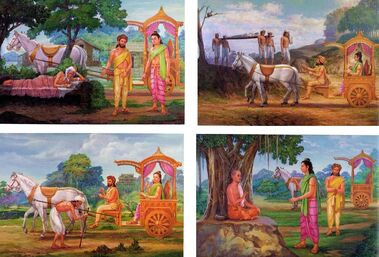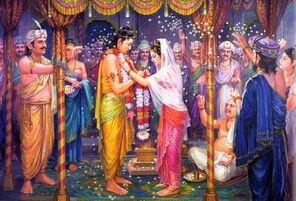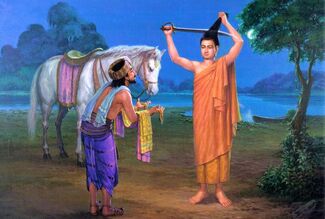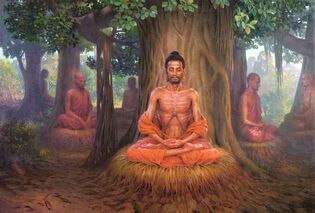Buddha’s Birth[]
The Buddha who is the founder of the Buddhist religion, Siddhartha Gautama, is called Buddha Shakyamuni. “Shakya” is the name of the royal family into which he wa
s born, and “Muni” means “Able One.” Buddha Shakyamuni was born as a royal prince in 624 BC in a place called Lumbini, in what is now Nepal. His mother’s name was Queen Mayadevi and his father’s name was King Shuddhodana.
The Queens Dream[]

One night, Queen Mayadevi dreamed that a white elephant descended from heaven and entered her womb. The white elephant entering her womb indicated that on that very night she had conceived a child who was a pure and powerful being. The elephant’s descending from heaven indicated that her child came from Tushita heaven, the Pure Land of Buddha Maitreya. Later, when she gave birth to the child, instead of experiencing pain the queen experienced a special, pure vision in which she stood holding the branch of a tree with her right hand while the gods Brahma and Indra took the child painlessly from her side. They then proceeded to honor the infant by offering him ritual ablutions.
The Kings Delight[]

When the king saw the child he felt as if all his wishes had been fulfilled and he named the young prince “Siddhartha.” He invited a Brahmin seer to make predictions about the prince’s future. The seer examined the child with his clairvoyance and told the king, “There are signs that the boy could become either a chakravatin king, a ruler of the entire world, or a fully enlightened Buddha. However, since the time for chakravatin kings is now past it is certain that he will become a Buddha, and that his beneficial influence will pervade the thousand million worlds like the rays of the sun.”
The Young Prince[]
As the young prince grew up he mastered all the traditional arts and sciences without needing any instruction. He knew

sixty-four different languages, each with their own alphabet, and he was also very skilled at mathematics. He once told his father that he could count all the atoms in the world in the time it takes to draw a single breath. Although he did not need to study, he did so to please his father and to benefit others. At his father’s request he joined a school where, in addition to various academic subjects, he became skilled at sports such as martial arts and archery. The prince would take every opportunity to convey spiritual meanings and to encourage others to follow spiritual paths. At one time, when he was taking part in an archery contest, he declared, “With the bow of meditative concentration I will fire the arrow of wisdom and kill the tiger of ignorance in living beings.” He then released the arrow and it flew straight through five iron tigers and seven trees before disappearing into the earth! By witnessing demonstrations such as this, thousands of people developed faith in the prince.
Witnessing Suffering[]
Sometimes Prince Siddhartha would go into the capital city of his father’s kingdom to see how the people lived. During these visits he came into contact with many old

people and sick people, and on one occasion he saw a corpse. These encounters left a deep impression on his mind and led him to realize that all living beings without exception have to experience the sufferings of birth, sickness, ageing and death. Because he understood the laws of reincarnation he also realized that they experience these sufferings not just once, but again and again, in life after life without cessation. Seeing how all living beings are trapped in this vicious circle of suffering he felt deep compassion for them, and he developed a sincere wish to free all of them from their suffering. Realizing that only a fully enlightened Buddha has the wisdom and the power to help all living beings in this way, he resolved to leave the palace and retire to the solitude of the forest where he would engage in profound meditation until he attained enlightenment.
Marriage[]

When the people of the Shakya kingdom realized that the prince intended to leave the palace they requested the king to arrange a marriage for him in the hope that this would cause him to change his mind. The king agreed and soon found him a suitable bride, the daughter of a respected Shakya family, called Yasodhara. Prince Siddhartha, however, had no attachment to worldly pleasures because he realized that objects of attachment are like poisonous flowers, which initially appear to be attractive but eventually give rise to great pain. His resolve to leave the palace and to attain enlightenment remained unchanged, but to fulfill his father’s wishes and to bring temporary benefit to the Shakya people, he agreed to marry Yasodhara. However, even though he remained in the palace as a royal prince, he devoted all his time and energy to serving the Shakya people in whatever way he could.
Prince Siddhartha’s Request[]
When he was twenty-nine years old, the prince had a vision in which all the Buddhas of the ten directions appeared to him and spoke in unison saying, Previously you

resolved to become a Conqueror Buddha so that you could help all living beings trapped in the cycle of suffering. Now is the time for you to accomplish this.” The prince went immediately to his parents and told them of his intention: “I wish to retire to a peaceful place in the forest where I can engage in deep meditation and quickly attain full enlightenment. Once I have attained enlightenment I shall be able to repay the kindness of all living beings, and especially the great kindness that you have shown me. Therefore I request your permission to leave the palace.” When his parents heard this they were shocked, and the king refused to grant his permission. Prince Siddhartha said to his father “Father, if you can give me permanent freedom from the sufferings of birth, sickness, ageing and death I shall stay in the palace; but if you cannot I must leave and make my human life meaningful.”
The Prince's Escape[]
The king tried all means to prevent his son from leaving the palace. In the hope that the prince might change his mind, he surrounded him with a retinue of beautiful

women, dancers, singer, and musicians, who day and night used their charms to please him; and in case the prince might attempt a secret escape he posted guards around the palace walls. However, the prince’s determination to leave the palace and enter a life of meditation could not be shaken. One night he used his miracle powers to send the guards and attendants into a deep sleep while he made his escape from the palace with the help of a trusted aide. After they had traveled about six miles, the prince dismounted from his horse and bade farewell to his aide. He then cut off his hair and threw it into the sky, where it was caught by the gods of the Land of the Thirty-three Heavens. One of the gods then offered the prince the saffron robes of a religious mendicant. The prince accepted these and gave his royal garments to the god in exchange. In this way he ordained himself as a monk.
A Suitable Place for Meditation[]

Siddhartha then made his way to a place near Bodh Gaya in India, where he found a suitable site for meditation. There he remained, emphasizing a meditation called
“space-like concentration on the Dharmakaya” in which he focused single-pointedly on the ultimate nature of all phenomena. After training in this meditation for six years he realized that he was very close to attaining full enlightenment, and so he walked to Bodh Gaya where, on the full moon day of the fourth month of the lunar calendar, he seated himself beneath the Bodhi Tree in the meditation posture and vowed not to rise from meditation until he had attained perfect enlightenment. With this determination he entered the space-like concentration on the Dharmakaya.
Conquering all Distractions[]
As dusk fell, Devaputra Mara, the chief of all the demons, or maras, in this world, tried to disturb Siddhartha’s concentration by conjuring up many fearful apparitions. He

manifested hosts of terrifying demons, some throwing spears, some firing arrows, some trying to burn him with fire, and some hurling boulders and even mountains at him. Through the force of his concentration, the weapons, rocks, and mountains appeared to him as a rain of fragrant flowers, and the raging fires became like offerings of rainbow lights.
With this concentration he removed the final veils of ignorance from his mind and in the next moment became a Buddha, a fully enlightened being. Seeing that Siddhartha could not be frightened into abandoning his meditation, Devaputra Mara tried instead to distract him by manifesting countless beautiful women, but Siddhartha responded by developing even deeper concentration. In this way he triumphed over all the demons of this world, which is why he subsequently became known as a “Conqueror Buddha.”

Attaining Enlightenment[]
Siddhartha then continued with his meditation until dawn, when he attained the varja-like concentration. With this concentration, which is the very last mind of a limited being, he removed the final veils of ignorance from his mind and in the next moment became a Buddha, a fully enlightened being.
